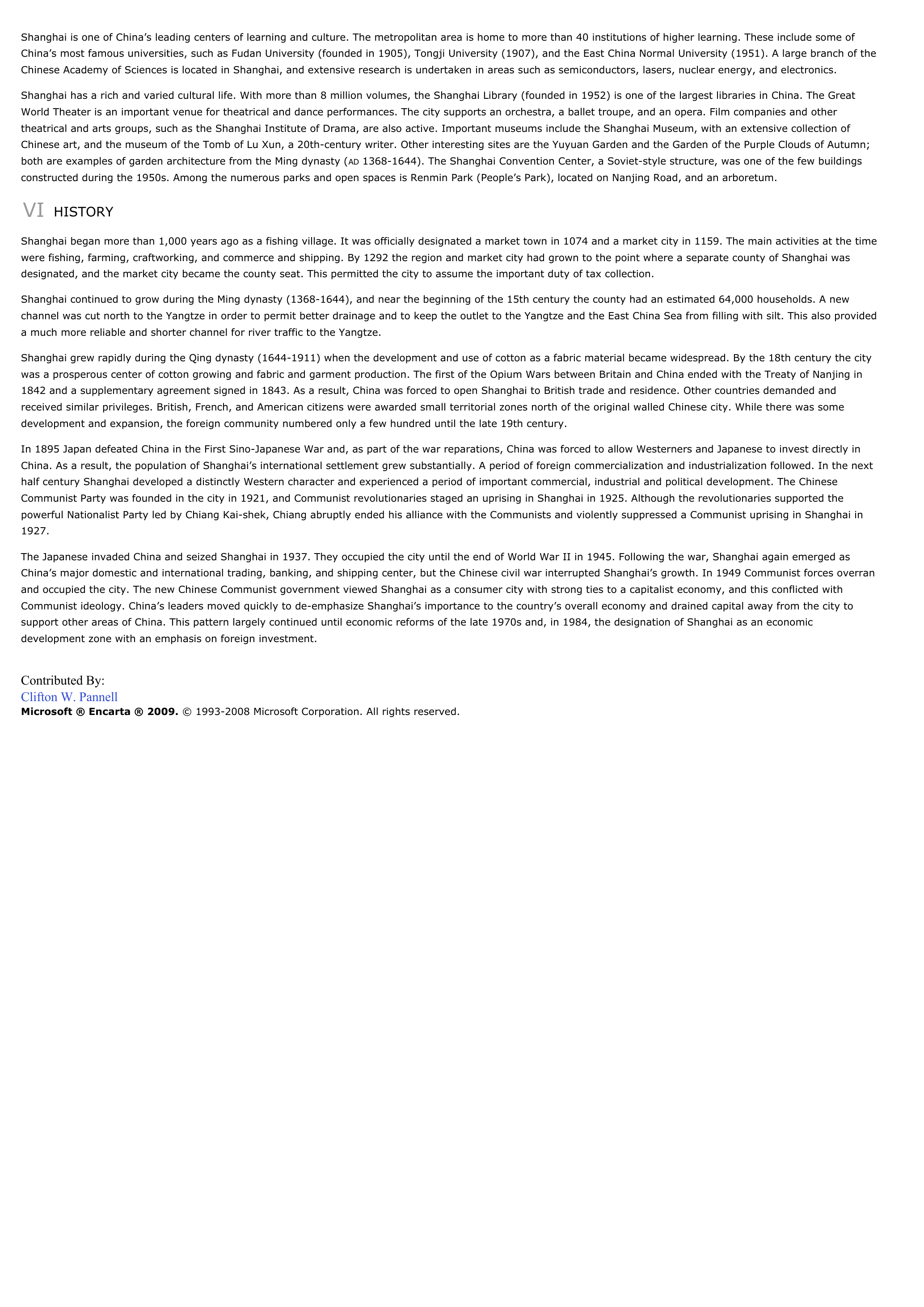Shanghai - geography.
Publié le 27/05/2013
Extrait du document
«
Shanghai is one of China’s leading centers of learning and culture.
The metropolitan area is home to more than 40 institutions of higher learning.
These include some ofChina’s most famous universities, such as Fudan University (founded in 1905), Tongji University (1907), and the East China Normal University (1951).
A large branch of theChinese Academy of Sciences is located in Shanghai, and extensive research is undertaken in areas such as semiconductors, lasers, nuclear energy, and electronics.
Shanghai has a rich and varied cultural life.
With more than 8 million volumes, the Shanghai Library (founded in 1952) is one of the largest libraries in China.
The GreatWorld Theater is an important venue for theatrical and dance performances.
The city supports an orchestra, a ballet troupe, and an opera.
Film companies and othertheatrical and arts groups, such as the Shanghai Institute of Drama, are also active.
Important museums include the Shanghai Museum, with an extensive collection ofChinese art, and the museum of the Tomb of Lu Xun, a 20th-century writer.
Other interesting sites are the Yuyuan Garden and the Garden of the Purple Clouds of Autumn;both are examples of garden architecture from the Ming dynasty ( AD 1368-1644).
The Shanghai Convention Center, a Soviet-style structure, was one of the few buildings constructed during the 1950s.
Among the numerous parks and open spaces is Renmin Park (People’s Park), located on Nanjing Road, and an arboretum.
VI HISTORY
Shanghai began more than 1,000 years ago as a fishing village.
It was officially designated a market town in 1074 and a market city in 1159.
The main activities at the timewere fishing, farming, craftworking, and commerce and shipping.
By 1292 the region and market city had grown to the point where a separate county of Shanghai wasdesignated, and the market city became the county seat.
This permitted the city to assume the important duty of tax collection.
Shanghai continued to grow during the Ming dynasty (1368-1644), and near the beginning of the 15th century the county had an estimated 64,000 households.
A newchannel was cut north to the Yangtze in order to permit better drainage and to keep the outlet to the Yangtze and the East China Sea from filling with silt.
This also provideda much more reliable and shorter channel for river traffic to the Yangtze.
Shanghai grew rapidly during the Qing dynasty (1644-1911) when the development and use of cotton as a fabric material became widespread.
By the 18th century the citywas a prosperous center of cotton growing and fabric and garment production.
The first of the Opium Wars between Britain and China ended with the Treaty of Nanjing in1842 and a supplementary agreement signed in 1843.
As a result, China was forced to open Shanghai to British trade and residence.
Other countries demanded andreceived similar privileges.
British, French, and American citizens were awarded small territorial zones north of the original walled Chinese city.
While there was somedevelopment and expansion, the foreign community numbered only a few hundred until the late 19th century.
In 1895 Japan defeated China in the First Sino-Japanese War and, as part of the war reparations, China was forced to allow Westerners and Japanese to invest directly inChina.
As a result, the population of Shanghai’s international settlement grew substantially.
A period of foreign commercialization and industrialization followed.
In the nexthalf century Shanghai developed a distinctly Western character and experienced a period of important commercial, industrial and political development.
The ChineseCommunist Party was founded in the city in 1921, and Communist revolutionaries staged an uprising in Shanghai in 1925.
Although the revolutionaries supported thepowerful Nationalist Party led by Chiang Kai-shek, Chiang abruptly ended his alliance with the Communists and violently suppressed a Communist uprising in Shanghai in1927.
The Japanese invaded China and seized Shanghai in 1937.
They occupied the city until the end of World War II in 1945.
Following the war, Shanghai again emerged asChina’s major domestic and international trading, banking, and shipping center, but the Chinese civil war interrupted Shanghai’s growth.
In 1949 Communist forces overranand occupied the city.
The new Chinese Communist government viewed Shanghai as a consumer city with strong ties to a capitalist economy, and this conflicted withCommunist ideology.
China’s leaders moved quickly to de-emphasize Shanghai’s importance to the country’s overall economy and drained capital away from the city tosupport other areas of China.
This pattern largely continued until economic reforms of the late 1970s and, in 1984, the designation of Shanghai as an economicdevelopment zone with an emphasis on foreign investment.
Contributed By:Clifton W.
PannellMicrosoft ® Encarta ® 2009. © 1993-2008 Microsoft Corporation.
All rights reserved..
»
↓↓↓ APERÇU DU DOCUMENT ↓↓↓
Liens utiles
- Shanghai - geography.
- Toumanova Tamara, 1919-1996, née dans un train près de Shanghai, danseuse russo-américaine.
- Shanghai ou Chang-hai.
- Shanghai - geographie.
- Shanghai - geografía.

































